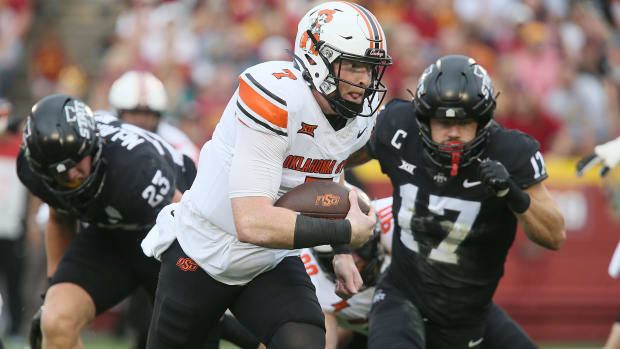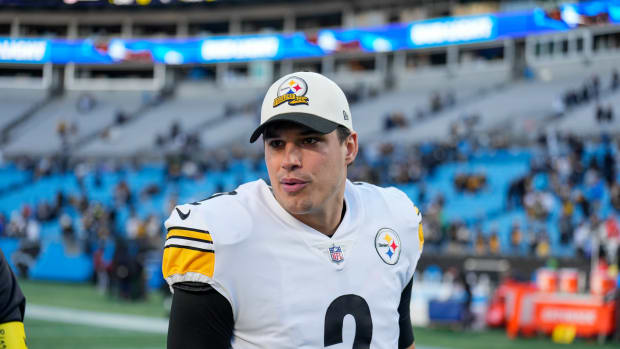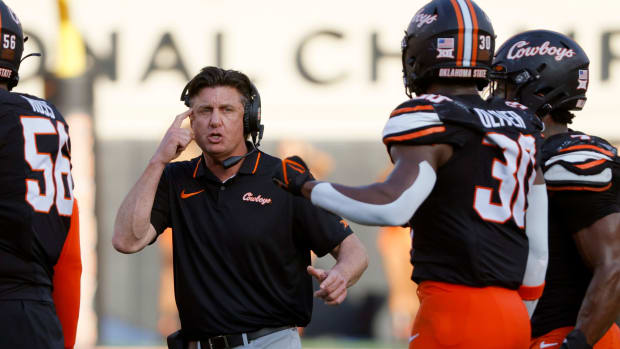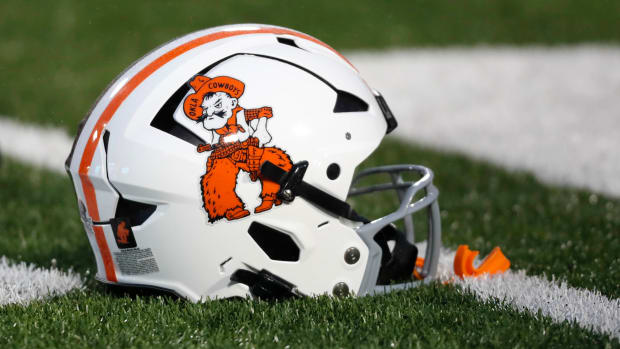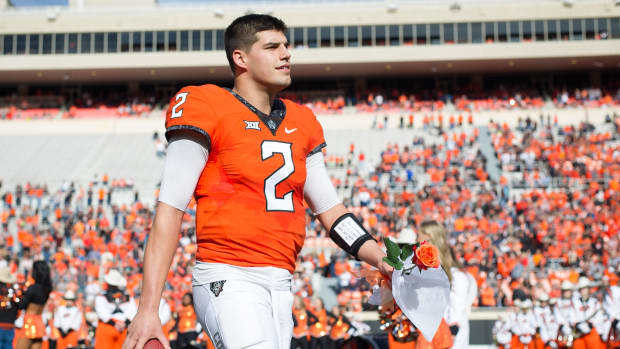Anthony Diaz was Part of a Miracle and Now Could Be Part of the Oklahoma State Football Cure
STILLWATER -- The media attention and agenda laced coverage continues surrounding the Oklahoma State football program following last week's call out by All-American running back Chuba Hubbard and other players of head coach Mike Gundy. The actual crux of the situation is now be out there following meetings, media accounts, and some involved revealing what has gone on inside the program since the call out. The players want greater relationships and connection with head coach Mike Gundy and the football staff. Not just with football business, but on more of a human level. There is no more of a human level or situation than life or death.
Anthony Diaz faced that situation and his teammates, coaches, and most critically, the sports medicine staff faced it with him. The incident with Diaz has been portrayed in coverage of the recent issues at Oklahoma State in football. The details have been misreported, but before we revert back and tell the story of Tuesday, Nov. 26., let's meet Anthony Diaz.
The former Broken Arrow High School multiple sport athlete in football and track is doing great these days. Since his football career ended he has stayed in school, founded a clothing brand company, Tulsa Made. He is currently at home with his mother and family. Later this summer he will return to Stillwater and will be a student assistant coach for the Cowboys working with the defensive backs.
"If I could sum up my life in one word it would be miracle," Diaz said opening the conversation. "Phyically, I feel better than I ever have and mentally, I'm on top of it. Spirtually, I'm at peace and I'm chugging along."
Out of high school, Diaz was moving along too. He first signed a letter of intent with and attended the Air Force Academy, but he says he knew that summer in basic training that the Air Force Academy wasn't for him. He came home, not knowing what would be next. He'd had 14 offers in football from NCAA, NAIA, and junior college, but it was too late. His high school track coach, Scott Wilkinson, found him a place on the track team at Oral Roberts for former Oklahoma State record breaking pole vaulter Joe Dial. Diaz competed in track for ORU but after nearly tearing his achilles tendon. His good friend and often workout partner was Oklahoma State walk-on slot receiver Landon Wolf. Wolf, a huge walk-on success story suggested Diaz try that path with Cowboy football.
"I contacted Coach (Mike) Groce (in charge of the walk-on program) and he had me come try out, but I ran one forty and they told me they wanted me," Diaz said. "I don't even know what my time was."
Now, Diaz was a walk-on defensive back for Oklahoma State. His attitude was good and even though he didn't play, his attitude was good and he loved being out there. He talks about his relationship with Coach (Tim) Duffie and his teammates.
He said the day of his heart attack that he felt good. He had gone to a lift session that morning. He felt good throughout the day and right up to when he collapsed during the early portions of practice that Tuesday.
"It was Bedlam and so everybody was locked in and focused from Chuba to somebody like me that was running scout team," Diaz explained.
So what does Diaz remember?
"First, I'm going to thank the Oklahoma State training staff and they knew what to do," he said of head of sports training John Stemm and head football trainer Scott Parker. "They knew what was happening to me and they were standing just 10 feet behind me when I collapsed."
As you would expect, it is all very fuzzy for Diaz.
"It was like a blink of an eye, one second I'm on a knee and I'm asking a (student) trainer for some water and then the next second I feel the bouncing," Diaz said what he remembered.
Being an eyewitness, I can tell you that as soon as he dropped and Stemm and Parker got to him, it was quickly felt throughout the Sherman Smith Training Center how serious this was. You don't forget seeing two men begin life saving measures on somebody.

If you look at the lover left corner of this picture that is roughly where Anthony Diaz collapsed on Tuesday, Nov. 26, 2019.
Oklahoma State University football
Head coach Mike Gundy got over there and found out the situation and who it was. Director of football operation Mack Butler and the assistant director of operations Rod Johnson were there. Gundy had the staff move the players out on the turf field next to the Sherman Smith Center, half the team was out there already as the offense and defense split the two fields. Gundy wanted the players out there while the two trainers attempted to bring Diaz back to life. Gundy had Johnson bring the doors down on the Smith Center and while Gundy remained inside with a look on his face that showed he was realizing any coaches greatest fear, having one of the their players lives threatened on the field, the rest of the coaches and the players outside prayed.

Mike Gundy had the look of fear as he watched John Stemm and Scott Parker bring Anthony Diaz back to life that day.
Oklahoma State University football
I saw the prayer and then I went back inside in a door about 30-yards from where Diaz was down. You could hear the ambulance siren heading toward the Sherman Smith Center and when it arrived the EMT's came in with a gurney. By then Stemm and Parker had Diaz heart beating, a pulse, and he was breathing.
Gundy, aware of this, had Johnson open the doors back up and by the time Diaz was being wheeled to the ambulance his teammates were able to see he was okay. He was propped up on the gurney and talking to the EMT's.
"When I tell you it felt like a movie or a video game, it really felt like a dream," Diaz explained. "I remember the bumping and the ambulance doors opening and I open my eyes and I remember thinking, 'I'm in a dream.' I moved my fingers and my toes and blinked my eyes and said to myself, 'Guy, this is a dream and please allow me to wake up.' I opened my eyes and looked down and saw my cleats, and I thought, 'this is a really detailed dream.' I had my pads on and everything and then the guys were looking at me and saying, 'he's alive.' I closed my eyes again and said, 'I'm in a dream. Do I feel fine? Yes. Am I moving? Yes. My extremities are fine. I remember asking one of the guys, 'what happened?' He said, ''You passed out and we had to bring you back to life.' 'Back to life, I thought.'"
After the ambulance left speeding Diaz to Stillwater Medical Center where later that very day he was transferred to the Oklahoma Heart Hospital in Tulsa, Okla., Gundy gathered the team. He had them group up on the field like they do to end practice and he had John Stemm and Scott Parker with him in front and told the team that these two men had just saved Diaz' life. The the team prayed again.
Diaz said Gundy called him that night and they spoke again that Saturday as Diaz was able to attend the Bedlam game. He also made the bowl trip to Houston and he said he spoke to the head coach during the Texas Bowl trip.
"It's been a medical miracle," Diaz states. "I had no oxygen in me for five to eight minutes. I had no pulse. Statistically, in the medical world when you have no oxygen in three minutes that is when there is brain injury, becoming paralyzed. This is what you hear in all those ER stories and on the movies, really bad thing happening to people and to their brain or nervous system, and for me to have no oxygen for five-to-eight minutes and not have any permanent injury, that alone is a miracle. I mean I was propped up on the gurney and talking."
The doctors found an arrhythmia and Diaz, who felt amazingly well alomost immediately after his ordeal, had surgery to insert an implantable cardioverter-defibrillator (ICD) in his heart. Even after surgery, his heartbeat was fine.
"I'm doing great," Diaz said after telling me that he had just been to the doctor earlier this week. "You know the doctor text me yesterday (after the stress test) and said, 'how do you feel?' I feel fine, I said. He said, 'Do you really feel good?' I told him that I feel better than I've ever been. It's been a miracle and it's not only been a testimony to my faith but to my teammates, my coaches, Coach Gundy that you know how something so bad can turn into something so good."
Diaz said he isn't sure what his life direction is supposed to be, but he thanks God that he has that problem and he is listening to God and others to help him.
"I had players like Trace Ford, Chuba, Kanion Williams, and people come up to me and say, 'What I say that day forever changed my life.' It wasn't anything that I did, it is what happens to you, what happens to you. It's been a blessing and my life has been a movie and I can only be thankful for it."
It is the one true miracle that I've ever witnessed on the football field. It is a memory that I could never forget. You might forget your first touchdown witnessed in person or that game winning home run but a life saved, that is hard to erase and why would you want to.
With Diaz back with the team, his spirit and attitude can be a reminder to everybody in the program, players, coaches, and support staff; that being a part of college football is a huge blessing and it is worth doing everything right to maximize the experience. You know Diaz will be.
